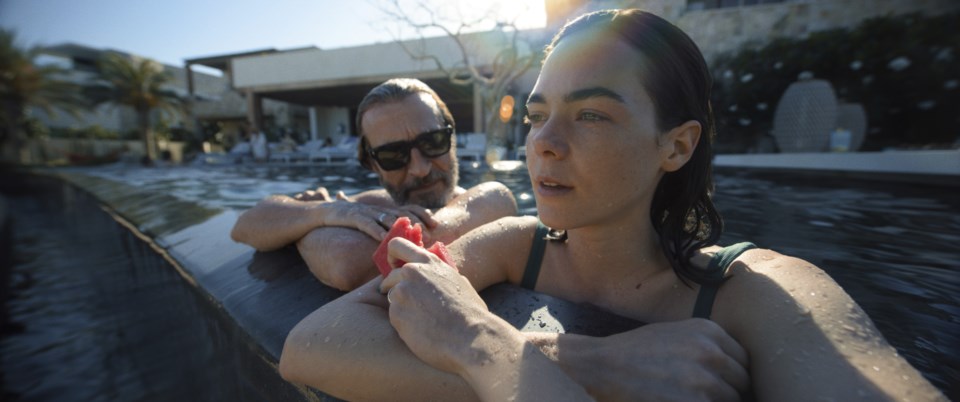In the swaggering, maximalist cinema of Alejandro Iñárritu, Iñárritu has, himself, never been all that far off the screen.
Since his blistering debut in âAmores Perrosâ to his seamless, surrealistic âBirdman or (The Unexpected Virtue of Ignorance),â Iñárrituâs showman-like presence has been easy to feel prodding and propelling the picture along in a ravenous hunt for transcendent images and spiritual epiphany.
In Iñárritu has turned within with just as much zeal as he brought to a bear fight in âThe Revenant.â As with all of Iñárrituâs films, âBardoâ isnât just deeply felt but impassioned to the max, with grand designs to not just plunge into his own soul but that of Mexico, too. For a filmmaker always pushing for more â including those titles that stretch on and on â âBardoâ is his most ambitious and indulgent film yet.
âBardo,â which has been trimmed since but still runs more than 2 1/2-hours, is Iñárrituâs stab at a familiar kind of auteur magnum-opus project: the movie memoir. Like Felliniâs â8 1/2,â it takes a tragicomic, circus-like approach in presenting the life of Iñárrituâs alter ego, a famous documentary filmmaker named Silverio (Daniel Giménez Cacho).
And while there are many dazzling moments to Iñárrituâs extravagant, fictionalized autobiography, itâs also tiresomely focused on no one but Silverio. For all its freewheeling surrealism â one scene puts the conquistador Hernán Cortés atop a pyramid of naked human corpses â âBardoâ is too self-obsessed to be much distracted by anything but Silverioâs mid-life worries: his mortality, his success, his family. Characters â including his wife, LucÃa (Griselda Siciliani), and children, (Ãker Sánchez Solano, Ximena Lamadrid) â pass by more like props to his existential journey.
When such inward-looking films work, I think, theyâre filled with observations and portraits not just of the artist. Alfonso Cuarónâs âRoma,â which shares âBardoâ production designer Eugenio Caballero in common, turned, really, on the housekeeper (Yalitza Aparicio). In Terrence Malickâs âTree of Life,â itâs the parents (Brad Pitt, Jessica Chastain) that glow. Even in James Grayâs just-released âArmageddon Time,â which, like âBardo,â was shot by cinematographer Darius Khondji, the focus is less on Gray as a young boy than on his family and classmates. For these filmmakers and many more, the self is less a protagonist than a prism â a starting gate not a finish line.
Unlike those films, Iñárrituâs self-portrait lives less in memory and more in the present â albeit a present peopled by ghosts. The film opens with the arresting image of a manâs long, thin shadow on barren plains. Heâs walking then running and then with a skyward leap lifted â like Birdman or the opening dream sequence of â8 1/2â â aloft. After the process repeats, heâs soaring above the desert when the film properly starts. Did he ever come down? Does he want to?
A similar question hovers over the filmâs first proper scene. Silverio and his wife give birth to a baby, Mateo, who the doctors report would rather go back into the womb. The worldâs too messed up, Mateo informs the doctors. Satirical news reports on television in coming scenes suggest the newborn has a point. Amazon, we overhear, is purchasing the Baja Peninsula.
Like passageways of thought, corridors and hallways crowd the early sections of âBardo." (It opens in theaters Friday and debuts next month on Netflix.) âLife is nothing but a series of senseless events and idiotic images,â Silverio says, explicitly stating not just a guiding principle of Iñárrituâs films but the overarching architecture of âBardo,â a fantasia that flits between fantasy and reality. In one scene, a conversation between Silverio and an American politician that turns to the Mexican-American War, they're surrounded by 19th century soldiers acting out a battle.
âBardoâ is Iñárrituâs first film made largely in Mexico since 2000's âAmores Perros." It's a homecoming, and one very much invested in what it means for one of Mexico's most famous Hollywood filmmakers to return home. A prestigious award awaits Silvio (Iñárritu, a filmmaker of assertive virtuosity, is coming off back-to-back best director Oscars) but he's plagued by feelings of guilt for finding fame in Los Angeles. This is especially debated with a former colleague, a TV host who accuses him of being a pretentious sellout and criticizes him for profiting on the pain of undocumented immigrants. (Iñárritu, himself, made that put the viewer within a migrant experience.)
But how much sympathy can we muster for a wealthy, celebrated filmmaker on holiday? It's hard not to roll your eyes when Silverio says things like, âSuccess has been my biggest failure." The award ceremony scenes make up the largest section of the film, and Iâm not sure why. Much comes across as a superficial spectacle of self-doubt. I liked âBardoâ more as a drama of dislocation, as an immigrant tale where no place, really, is home, anymore. There are a few scenes here that feel directly taken from Iñárritu's subconscious. That ego gets in the way of insight is one of the subjects of âBardo," but also, maybe, its undoing.
âBardo, False Chronicle of a Handful of Truths,â a Netflix release, is rated R by the Motion Picture Association of America for language throughout, strong sexual content and graphic nudity. Running time: 157 minutes. Two and a half stars out of four.
___
Follow AP Film Writer Jake Coyle on Twitter at: http://twitter.com/jakecoyleAP
Jake Coyle, The Associated Press



